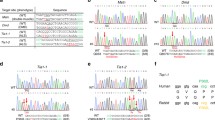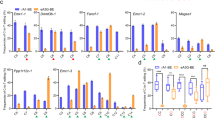Abstract
Evolved xCas9(3.7) variant with broad PAM compatibility has been reported in cell lines, while its editing efficiency was site-specific. Here, we show that xCas9(3.7) can recognize a broad PAMs including NGG, NGA, and NGT, in both embryos and Founder (F0) rabbits. Furthermore, the codon-optimized xCas9-derived base editors, exBE4 and exABE, can dramatically improve the base editing efficiencies in rabbit embryos. Our results demonstrated that the optimized xCas9 with expanded PAM compatibility and enhanced base editing efficiency could be used for precise gene modifications in organisms.




Similar content being viewed by others
Data availability
The authors state that all data necessary for confirming the conclusions presented in the article are represented fully within the article or from the authors upon request.
References
Cong L, Ran FA, Cox D, Lin S, Barretto R, Habib N, Hsu PD, Wu X, Jiang W, Marraffini LA, Zhang F (2013) Multiplex genome engineering using CRISPR/Cas systems. Science (New York, NY) 339(6121):819–823. https://doi.org/10.1126/science.1231143
Knott GJ, Doudna JA (2018) CRISPR-Cas guides the future of genetic engineering. Science 361(6405):866–869. https://doi.org/10.1126/science.aat5011
Komor AC, Kim YB, Packer MS, Zuris JA, Liu DR (2016) Programmable editing of a target base in genomic DNA without double-stranded DNA cleavage. Nature 533(7603):420–424. https://doi.org/10.1038/nature17946
Gaudelli NM, Komor AC, Rees HA, Packer MS, Badran AH, Bryson DI, Liu DR (2017) Programmable base editing of A*T to G*C in genomic DNA without DNA cleavage. Nature 551(7681):464–471. https://doi.org/10.1038/nature24644
Kim JS (2018) Precision genome engineering through adenine and cytosine base editing. Nat Plants 4(3):148–151. https://doi.org/10.1038/s41477-018-0115-z
Ran FA, Hsu PD, Wright J, Agarwala V, Scott DA, Zhang F (2013) Genome engineering using the CRISPR-Cas9 system. Nat Protoc 8(11):2281–2308. https://doi.org/10.1038/nprot.2013.143
Hu JH, Miller SM, Geurts MH, Tang W, Chen L, Sun N, Zeina CM, Gao X, Rees HA, Lin Z, Liu DR (2018) Evolved Cas9 variants with broad PAM compatibility and high DNA specificity. Nature 556(7699):57–63. https://doi.org/10.1038/nature26155
Gehrke JM, Cervantes O, Clement MK (2018) An APOBEC3A-Cas9 base editor with minimized bystander and off-target activities. Nat Biotechnol 36(10):977–982. https://doi.org/10.1038/nbt.4199
Nishimasu H, Shi X (2018) Engineered CRISPR-Cas9 nuclease with expanded targeting space. Science 361(6408):1259–1262. https://doi.org/10.1126/science.aas9129
Song Y, Yuan L, Wang Y, Chen M, Deng J, Lv Q, Sui T, Li Z, Lai L (2016) Efficient dual sgRNA-directed large gene deletion in rabbit with CRISPR/Cas9 system. Cell Mol Life Sci CMLS 73(15):2959–2968. https://doi.org/10.1007/s00018-016-2143-z
Concordet JP, Haeussler M (2018) CRISPOR: intuitive guide selection for CRISPR/Cas9 genome editing experiments and screens. Nucleic Acids Res 46(W1):W242–W245. https://doi.org/10.1093/nar/gky354
Zhang Y, Ge X, Yang F, Zhang L, Zheng J, Tan X, Jin ZB, Qu J, Gu F (2014) Comparison of non-canonical PAMs for CRISPR/Cas9-mediated DNA cleavage in human cells. Sci Rep 4:5405. https://doi.org/10.1038/srep05405
Oetting WS, King RA (1999) Molecular basis of albinism: mutations and polymorphisms of pigmentation genes associated with albinism. Hum Mutat 13(2):99–115. https://doi.org/10.1002/(sici)1098-1004(1999)13:2%3c99:aid-humu2%3e3.0.co;2-c
Oetting WS (2000) The tyrosinase gene and oculocutaneous albinism type 1 (OCA1): a model for understanding the molecular biology of melanin formation. Pigment Cell Res 13(5):320–325
Kim K, Ryu SM, Kim ST, Baek G, Kim D, Lim K, Chung E, Kim S, Kim JS (2017) Highly efficient RNA-guided base editing in mouse embryos. Nat Biotechnol 35(5):435–437. https://doi.org/10.1038/nbt.3816
Liu Z, Chen M, Chen S, Deng J, Song Y, Lai L, Li Z (2018) Highly efficient RNA-guided base editing in rabbit. Nat Commun 9(1):2717. https://doi.org/10.1038/s41467-018-05232-2
Zhang Y, Qin W, Lu X, Xu J, Huang H, Bai H, Li S, Lin S (2017) Programmable base editing of zebrafish genome using a modified CRISPR-Cas9 system. Nat Commun 8(1):118. https://doi.org/10.1038/s41467-017-00175-6
Zong Y, Wang Y, Li C, Zhang R, Chen K, Ran Y, Qiu JL, Wang D, Gao C (2017) Precise base editing in rice, wheat and maize with a Cas9-cytidine deaminase fusion. Nat Biotechnol 35(5):438–440. https://doi.org/10.1038/nbt.3811
Shimatani Z, Kashojiya S, Takayama M, Terada R, Arazoe T, Ishii H, Teramura H, Yamamoto T, Komatsu H, Miura K, Ezura H, Nishida K (2017) Targeted base editing in rice and tomato using a CRISPR-Cas9 cytidine deaminase fusion. Nat Biotechnol 35(5):441–443. https://doi.org/10.1038/nbt.3833
Komor AC, Zhao KT, Packer MS, Gaudelli NM, Waterbury AL, Koblan LW, Kim YB, Badran AH, Liu DR (2017) Improved base excision repair inhibition and bacteriophage Mu Gam protein yields C:G-to-T: a base editors with higher efficiency and product purity. Sci Adv 3(8):eaao4774. https://doi.org/10.1126/sciadv.aao4774
Cruts M, Theuns J, Van Broeckhoven C (2012) Locus-specific mutation databases for neurodegenerative brain diseases. Hum Mutat 33(9):1340–1344. https://doi.org/10.1002/humu.22117
Goate A, Chartier-Harlin MC, Mullan M, Brown J, Crawford F, Fidani L, Giuffra L, Haynes A, Irving N, James L et al (1991) Segregation of a missense mutation in the amyloid precursor protein gene with familial Alzheimer’s disease. Nature 349(6311):704–706. https://doi.org/10.1038/349704a0
Sasaguri H, Nagata K, Sekiguchi M, Fujioka R, Matsuba Y, Hashimoto S, Sato K, Kurup D, Yokota T, Saido TC (2018) Introduction of pathogenic mutations into the mouse Psen1 gene by base editor and target-AID. Nat Commun 9(1):2892. https://doi.org/10.1038/s41467-018-05262-w
Hua K, Tao X, Yuan F, Wang D, Zhu JK (2018) Precise A·T to G·C base editing in the rice genome. Mol Plant 11(4):627–630. https://doi.org/10.1016/j.molp.2018.02.007
Yan F, Kuang Y, Ren B, Wang J, Zhang D, Lin H, Yang B, Zhou X, Zhou H (2018) High-efficient A·T to G·C base editing by Cas9n-guided tRNA adenosine deaminase in rice. Mol Plant 11(4):631–634. https://doi.org/10.1016/j.molp.2018.02.008
Ryu SM, Koo T, Kim K, Lim K, Baek G, Kim ST, Kim HS, Kim DE, Lee H, Chung E, Kim JS (2017) Adenine base editing in mouse embryos and an adult mouse model of Duchenne muscular dystrophy. Nat Biotechnol 36(6):536–539. https://doi.org/10.1038/nbt.4148
MacArthur DG, Manolio TA, Dimmock DP, Rehm HL, Shendure J, Abecasis GR, Adams DR, Altman RB, Antonarakis SE, Ashley EA, Barrett JC, Biesecker LG, Conrad DF, Cooper GM, Cox NJ, Daly MJ, Gerstein MB, Goldstein DB, Hirschhorn JN, Leal SM, Pennacchio LA, Stamatoyannopoulos JA, Sunyaev SR, Valle D, Voight BF, Winckler W, Gunter C (2014) Guidelines for investigating causality of sequence variants in human disease. Nature 508(7497):469–476. https://doi.org/10.1038/nature13127
Koblan LW, Doman JL, Wilson C (2018) Improving cytidine and adenine base editors by expression optimization and ancestral reconstruction. Nat Biotechnol 36(9):843–846. https://doi.org/10.1038/nbt.4172
Zafra MP, Schatoff EM, Katti A, Foronda M, Breinig M, Schweitzer AY, Simon A, Han T, Goswami S, Montgomery E, Thibado J, Kastenhuber ER, Sanchez-Rivera FJ, Shi J (2018) Optimized base editors enable efficient editing in cells, organoids and mice. Nat Biotechnol 36(9):888–893. https://doi.org/10.1038/nbt.4194
Lee JK, Jeong E, Lee J, Jung M, Shin E, Kim YH, Lee K, Jung I, Kim D, Kim S, Kim JS (2018) Directed evolution of CRISPR-Cas9 to increase its specificity. Nat Commun 9(1):3048. https://doi.org/10.1038/s41467-018-05477-x
Saito T, Matsuba Y, Mihira N, Takano J, Nilsson P, Itohara S, Iwata N, Saido TC (2014) Single App knock-in mouse models of Alzheimer’s disease. Nat Neurosci 17(5):661–663. https://doi.org/10.1038/nn.3697
Wang X, Li J, Wang Y, Yang B (2018) Efficient base editing in methylated regions with a human APOBEC3A-Cas9 fusion. Nat Biotechnol 36(10):946–949. https://doi.org/10.1038/nbt.4198
Zong Y, Song Q, Li C, Jin S, Zhang D, Wang Y, Qiu JL (2018) Efficient C-to-T base editing in plants using a fusion of nCas9 and human APOBEC3A. Nat Biotechnol 36:950–953. https://doi.org/10.1038/nbt.4261
Acknowledgements
The authors would like to thank Peiran Hu for assistance at the Embryo Engineering Center for the critical technical assistance.
Funding
This study was financially supported by the National Key Research and Development Program of China Stem Cell and Translational Research (2017YFA0105101), The Program for Changjiang Scholars and Innovative Research Team in University (No.IRT_16R32), The Strategic Priority Research Program of the Chinese Academy of Sciences (XDA16030501, XDA16030503), and Key Research & Development Program of Guangzhou Regenerative Medicine and Health Guangdong Laboratory(2018GZR110104004).
Author information
Authors and Affiliations
Contributions
ZL, MC, HS, and SC performed the experiment; ZL and LL conceived the idea and provided funding support; ZL, ZL, and LL wrote the manuscript. All authors reviewed the manuscript.
Corresponding authors
Ethics declarations
Conflict of interest
The authors declare no competing interest.
Additional information
Publisher's Note
Springer Nature remains neutral with regard to jurisdictional claims in published maps and institutional affiliations.
Electronic supplementary material
Below is the link to the electronic supplementary material.
Rights and permissions
About this article
Cite this article
Liu, Z., Chen, M., Shan, H. et al. Expanded targeting scope and enhanced base editing efficiency in rabbit using optimized xCas9(3.7). Cell. Mol. Life Sci. 76, 4155–4164 (2019). https://doi.org/10.1007/s00018-019-03110-8
Received:
Revised:
Accepted:
Published:
Issue Date:
DOI: https://doi.org/10.1007/s00018-019-03110-8




